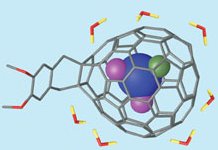Better
Contrast?
"It's important to exploit fullerenes' special properties," Robert Bolskar of the Wheat Ridge, Colo., company TDA Research told a meeting of the Electrochemical Society in May in Philadelphia. In diagnostic medicine, physicians often need to put molecules containing potentially hazardous metal atoms into a patient's body temporarily to highlight certain tissues so that physicians can see them better. If the contrast material remains in the patient long enough, the metal atoms may break free. However, these atoms can't escape from a fullerene cage and do mischief in the patient. Buckyballs may be especially useful for shuttling metal contrast agents through the body for magnetic resonance imaging (MRI) scans, Bolskar says. Bolskar, Lon Wilson of Rice University in Houston, and other researchers at TDA and Rice have designed carbon-60 and other fullerene molecules with an atom of gadolinium inside and with chemical appendages that make them water-soluble. In typical MRI contrast agents, the metal gadolinium is linked to a nonfullerene molecule. For most diagnostic tests, this molecule is excreted from the body quickly. However, fullerene-encapsulated gadolinium might one day be a safer option for certain diagnostic tests in which doctors leave the contrast agent in longer, Wilson says.
The degree of contrast provided by this molecule is comparable to that of ordinary MRI agents. So far, it has been tested in one rat, which survived without complications, Bolskar reports. To create an improved contrast agent for X-ray imaging, Wilson and his colleagues have also bonded multiple iodine atoms to the outside of C-60 molecules. Animal tests are just under way, Rice's Tim Wharton reported at the Electrochemical Society meeting. Currently, physicians use conventional molecules that include iodine. Still other researchers, including Harry Dorn and his coworkers at Virginia Tech in Blacksburg, are putting four atoms inside fullerene cages to create multiple-use contrast agents. They did this by developing a technique to trap three metal atoms inside a carbon-80 cage. The researchers also enclose one nitrogen atom that binds the metal atoms. Two of the metal atoms could be chosen for use in MRI imaging, and one for X rays, or visa versa, says Dorn. Virginia Tech has licensed the technology to a Blacksburg company called Luna nanoMaterials, which is developing new applications for the metal-filled cages.
References: Bolskar, R.D., et al. 2002. Development of Gd@C60-based MRI contrast agents. Abstract 224. 223rd American Chemical Society National Meeting. April 7-11. Orlando, Fla. Chen, B.-X., et al. 2002. Antibody to fullerenes binds carbon nanotubes. Abstract 989. 201st Meeting of the Electrochemical Society. May 12-17. Philadelphia. Dorn, H.C., and E.B. Iezzi. 2002. Novel derivatives of trimetallic nitride endohedral metallofullerenes for biological applications. Abstract 226. 223rd American Chemical Society National Meeting. April 7-11. Orlando, Fla. Dorn, H.C. 2002. Endohedral metallofullerenes as MRI contrast agents. Abstract 227. 223rd American Chemical Society National Meeting. April 7-11. Orlando, Fla. Erlanger, B. 2002. Interaction of fullerenes and nanotubes with antibodies. Abstract 186. 223rd American Chemical Society National Meeting. April 7-11. Orlando, Fla. Friedman, S.H. 2002. C60: A highly flexible scaffold for bioorganic design: From HIV protease inhibition to pharmacophore presentation. Abstract 985. 201st Meeting of the Electrochemical Society. May 12-17. Philadelphia. Sagman, U. 2002. Medicine balls- updates on the fullerene drug pipeline. Abstract 230. 223rd American Chemical Society National Meeting. April 7-11. Orlando, Fla. Wharton, T., and L.J. Wilson. 2002. Highly-iodinated fullerene as a contrast agent for X-ray imaging. Abstract 988. 201st Meeting of the Electrochemical Society. May 12-17. Philadelphia. Wilson, S.R. 2002. Nanomedicine—fullerene and nanotube biology. Abstract 182. 223rd American Chemical Society National Meeting. April 7-11. Orlando, Fla. ______. 2002. Nanomedicine: Fullerene and carbon nanotube biology. Abstract 983. 201st Meeting of the Electrochemical Society. May 12-17. Philadelphia. Further Readings: Wu, C. 1999. Altered buckyballs go straight to bone. Science News 155(May 8):292.
|
Uploaded: 12-14-05
